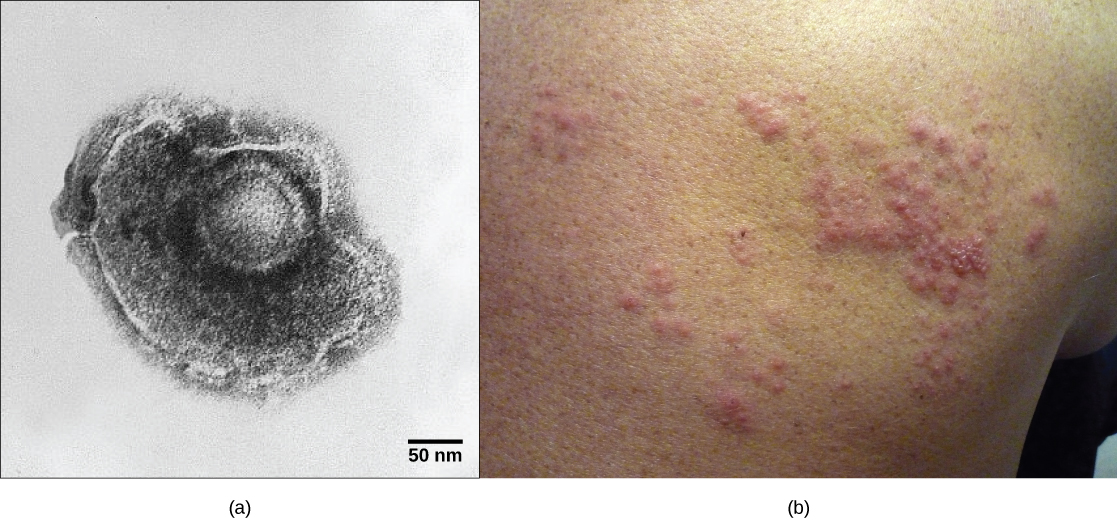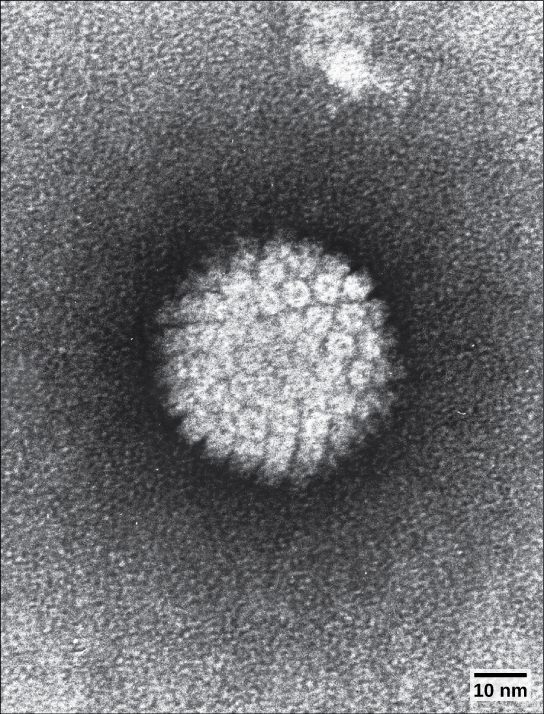| << Chapter < Page | Chapter >> Page > |

Some animal-infecting viruses, including the hepatitis C virus discussed above, are known as oncogenic viruses : They have the ability to cause cancer. These viruses interfere with the normal regulation of the host cell cycle either by either introducing genes that stimulate unregulated cell growth (oncogenes) or by interfering with the expression of genes that inhibit cell growth. Oncogenic viruses can be either DNA or RNA viruses. Cancers known to be associated with viral infections include cervical cancer caused by human papillomavirus (HPV) ( [link] ), liver cancer caused by hepatitis B virus, T-cell leukemia, and several types of lymphoma.

Visit the interactive animations showing the various stages of the replicative cycles of animal viruses and click on the flash animation links.
Plant viruses, like other viruses, contain a core of either DNA or RNA. You have already learned about one of these, the tobacco mosaic virus. As plant viruses have a cell wall to protect their cells, these viruses do not use receptor-mediated endocytosis to enter host cells as is seen with animal viruses. For many plant viruses to be transferred from plant to plant, damage to some of the plants’ cells must occur to allow the virus to enter a new host. This damage is often caused by weather, insects, animals, fire, or human activities like farming or landscaping. Additionally, plant offspring may inherit viral diseases from parent plants. Plant viruses can be transmitted by a variety of vectors, through contact with an infected plant’s sap, by living organisms such as insects and nematodes, and through pollen. When plants viruses are transferred between different plants, this is known as horizontal transmission , and when they are inherited from a parent, this is called vertical transmission .
Symptoms of viral diseases vary according to the virus and its host ( [link] ). One common symptom is hyperplasia , the abnormal proliferation of cells that causes the appearance of plant tumors known as galls . Other viruses induce hypoplasia , or decreased cell growth, in the leaves of plants, causing thin, yellow areas to appear. Still other viruses affect the plant by directly killing plant cells, a process known as cell necrosis . Other symptoms of plant viruses include malformed leaves, black streaks on the stems of the plants, altered growth of stems, leaves, or fruits, and ring spots, which are circular or linear areas of discoloration found in a leaf.
| Some Common Symptoms of Plant Viral Diseases | |
|---|---|
| Symptom | Appears as |
| Hyperplasia | Galls (tumors) |
| Hypoplasia | Thinned, yellow splotches on leaves |
| Cell necrosis | Dead, blackened stems, leaves, or fruit |
| Abnormal growth patterns | Malformed stems, leaves, or fruit |
| Discoloration | Yellow, red, or black lines, or rings in stems, leaves, or fruit |
Plant viruses can seriously disrupt crop growth and development, significantly affecting our food supply. They are responsible for poor crop quality and quantity globally, and can bring about huge economic losses annually. Others viruses may damage plants used in landscaping. Some viruses that infect agricultural food plants include the name of the plant they infect, such as tomato spotted wilt virus, bean common mosaic virus, and cucumber mosaic virus. In plants used for landscaping, two of the most common viruses are peony ring spot and rose mosaic virus. There are far too many plant viruses to discuss each in detail, but symptoms of bean common mosaic virus result in lowered bean production and stunted, unproductive plants. In the ornamental rose, the rose mosaic disease causes wavy yellow lines and colored splotches on the leaves of the plant.
Viral replication within a living cell always produces changes in the cell, sometimes resulting in cell death and sometimes slowly killing the infected cells. There are six basic stages in the virus replication cycle: attachment, penetration, uncoating, replication, assembly, and release. A viral infection may be productive, resulting in new virions, or nonproductive, which means that the virus remains inside the cell without producing new virions. Bacteriophages are viruses that infect bacteria. They have two different modes of replication: the lytic cycle, where the virus replicates and bursts out of the bacteria, and the lysogenic cycle, which involves the incorporation of the viral genome into the bacterial host genome. Animal viruses cause a variety of infections, with some causing chronic symptoms (hepatitis C), some intermittent symptoms (latent viruses such a herpes simplex virus 1), and others that cause very few symptoms, if any (human herpesviruses 6 and 7). Oncogenic viruses in animals have the ability to cause cancer by interfering with the regulation of the host cell cycle. Viruses of plants are responsible for significant economic damage in both agriculture and plants used for ornamentation.
[link] Influenza virus is packaged in a viral envelope that fuses with the plasma membrane. This way, the virus can exit the host cell without killing it. What advantage does the virus gain by keeping the host cell alive?
[link] The host cell can continue to make new virus particles.
[link] Which of the following statements is false?
[link] C

Notification Switch
Would you like to follow the 'Biology' conversation and receive update notifications?